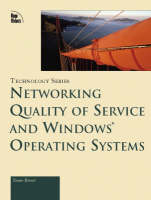
Networking Quality of Service and Windows Operating Systems
New Riders Publishing (Verlag)
978-1-57870-206-0 (ISBN)
- Titel ist leider vergriffen;
keine Neuauflage - Artikel merken
Windows Operating Systems and Quality of Service Networking provides an overview of Quality of Service technologies, and how they can be implemented in a Windows based system. Author Yoram Bernet is a leading authority on Quality of Service, having been one of the main architects of many QoS technologies in the IETF and a Program Manager for QoS at Microsoft. With the rapid increase in network traffic, network professionals have been scrambling to add capacity to their networks. But new applications, such as multimedia, keep driving up the demand for network services, and network traffic continues to increase. Quality of service technologies improve this situation by making efficient use of network capacity and giving you, the network professional control over how network capacity is allocated to various applications and users. This book explains the myriad QoS technologies that play a role in a QoS enabled network, with a focus on how to implement these technologies within Windows.
Yoram Bernet has led Microsoft in the formation of its QoS vision for the last four years, and has also played a leadership role in the Internet Engineering Task Force's QoS efforts. Currently an architect in Microsoft's Windows Networking Group, Yoram previously managed the Network QoS Development Group for Windows 2000. He has been an active participant and has authored several drafts in a number of IETF QoS-related working groups. Before his involvement with QoS specifically, Yoram designed the network infrastructure for the Microsoft Interactive TV program. Prior to his move to Microsoft, he worked at Memorex/Telex briefly, and at AT&T and Bell Labs for nine years. At AT&T, Yoram developed graphics hardware and, later, communications software. Yoram has a degree in biomedical engineering from Case Western Reserve University.
(NOTE: Each chapter concludes with a Summary.)
Introduction.
PART I.
1. Introduction to Quality of Service.
Defining Network QoS. The Network. Meeting Service Needs. Network Resources. Application Requirements. Fundamental QoS Resources and Traffic-Handling Mechanisms. Allocating QoS Resources in Network Devices. Traffic-Handling Mechanisms. 802 User_Priority. Differentiated Services. Integrated Services. ATM, ISSLOW, and Others. Per-Conversation versus Aggregate Traffic-Handling. Mechanisms. Provisioning and Configuration Mechanisms. Provisioning versus Configuration. Pushed versus Signaled Mechanisms. Resource Reservation Protocol and the Subnet Bandwidth Manager. Policy Mechanisms and Protocols. Summary. @CHAPTER 2. The Quality/Efficiency Product: The Reason to QoS-Enable a Network. Tradeoffs in the QoS-Enabled Network The Quality of a Service. Efficiency. The Quality/Efficiency Product. Raising the QE Product of a Network Quality, Efficiency, and Overhead. The Value of Different QoS Mechanisms in Raising the QE Product of a Network Overhead. Tabulating the Impact of QoS Mechanisms on QE Product and Overhead. Illustrative Examples. Push Provisioning and FIFO Traffic Handling. Using Aggregate Traffic Handling to Raise the QE Product. Supporting Higher-Quality Services in the LAN. Supporting Higher-Quality Services in the WAN. Raising the QE Product of the WAN Link by Using Signaling. Sharing Network Resources: Multiple Resource Pools. Isolation Between Traffic Types Requiring Different Quality Service. The Four Logical Networks. Summary.
3. Queuing Mechanisms.
Formation of Queues. Queuing and Forwarding. Congestion. Taxonomy of Queuing Mechanisms. FIFO Queuing. Work-Conserving Queuing. Non-Work-Conserving Queuing. Dropping Schemes and Congestion Avoidance. Evaluation of Queuing SchemeS. Processing Cost. Bandwidth and Latency Guarantees. Examples of Work-Conserving Queuing Schemes. Strict Priority Queuing. Fair Queuing Algorithms. Examples of Non-Work-Conserving Queuing Schemes. Shaping Parameters and Buckets. Link Sharing and Class-Based QueuinG. Sharing Hierarchy. Class-Based Queuing. Examples of Dropping Schemes. Problems with Tail Dropping. An Alternative to Tail Dropping: Random Early Detection. Application of Queuing Schemes. Passive Configuration of Queuing Schemes. Application Examples. Summary.
4. Integrated Services.
Overview of the IntServ Architecture. Integrated Services in the Internet: RFC 1633. Requirements Driving the IntServ Architecture and Their Implications. The IntServ Service Model. The Implementation Framework
The Services of the IntServ Model. Application Types and Their Requirements. The IntServ Services. Integrated Services Over Specific Link Layers. Summary. @CHAPTER 5.RSVP.
The History of RSVP. The Birth of RSVP. The Rise and Fall of RSVP. The Death Blow. The Renaissance of RSVP. RSVP Concepts. The Notion of a Reservation. Soft-State Model. Receiver Orientation. IP Multicast. RSVP Sessions. RSVP Messages and Basic Protocol Operation. The Structure of RSVP Messages. The Fundamental RSVP Messages: PATH and RESV. The Reservation Cycle. Multicast Operation. Merging Reservations. Reservation Styles. Receiver Heterogeneity and Reservation Styles. Policy and Security Admission Control Based on Policy. Policy Objects. Security. Policy Errors. Enhancements to RSVP. The SBM Protocol. Aggregate RSVP Signaling. RSVP over IP Tunnels. RSVP for MPLS. Refresh Reduction, Node Failure Detection, and Related Optimizations. DCLASS and TCLASS Objects. RSVP with IP Security. Issues in the Application of RSVP. Admission Control Agents. Signaling for Qualitative Applications. RSVP Proxies. Snooping. Summary.
6. Differentiated Services.
The History and Background of Differentiated Services. Formation of the DiffServ Working Group and Its Charter. DiffServ and RSVP/IntServ. The Perspective of the DiffServ Provider. Differentiated Service Architecture and Concepts Per-Hop Behaviors and DiffServ Codepoints. Services versus PHBs. Traffic Conditioning, Service Level Specifications, and Service Level Agreements. Standard Per-Hop Behaviors. The Expedited Forwarding PHB. The Assured Forwarding PHB Group. The Class Selector PHB Group. Providing Services. Providers, Customers, and Network Boundaries. Traffic Constraints and Quality of Offered Services. Levels of Service Guarantees. The Scope and Extent of a DiffServ Service. Static versus Dynamic Service Level Specifications. Traffic Conditioning. Traffic-Conditioning Components. Using Traffic-Conditioning Blocks to Build Differentiated Services. TCB Supporting VLL Service at the DiffServ Ingress. TCB Providing VLL Service with Marking and Shaping. Ingress TCB Providing Olympic Services and BBE Service Using. The AF PHB Group. Provisioning the DiffServ Network. Boundary Provisioning versus Interior Provisioning. Boundary Provisioning. Interior Provisioning. Static versus Dynamic Provisioning. Policy in the DiffServ Network. Policy Components. The Push Provisioning Model. The Signaling Provisioning Model. Provisioning Based on Real-Time Measurement. DiffServ with RSVP Admission Control. Traffic Classification. The DCLASS Object. Mapping RSVP Signaled Services to DiffServ Services. Issues in DiffServ. Customer Traffic Conditioning versus Provider Traffic. Conditioning. Mapping from DiffServ to Other QoS Mechanisms. Multicast. IPSec and DiffServ. Tunneling and DiffServ. Summary.
7.The Subnet Bandwidth Manager and 802 Networks.
User_Priority. Comparison to Differentiated Services. Providing Services Based on user_priority. Using RSVP with 802 Networks—the SBM and SBM Protocol. The SBM as Admission Control Agent for 802 Networks. The SBM Protocol. Admission Control at DSBMs and the TCLASS Object. Supporting Heterogeneous Senders on 802 Subnets Legacy 802 Subnets. Summary.
8. QoS over Layer 2 Media Other Than 802.
ATM and QoS. Fundamental ATM Concepts. Mapping IP to ATM. Using ATM to Provide QoS. IP over ATM and LAN Emulation. Frame Relay and QoS. Overview of Frame Relay. QoS in the Frame Relay Network. Using Frame Relay to Provide QoS. QoS on Low-Bit Rate Links. Supporting Different Qualities of Service. Bandwidth Constraints and Admission Control. Traffic Handling to Minimize Latency. Summary.
9. QoS Policy.
Defining the Concept of Policy. Examples of QoS Policy Objectives. Features of a Policy Management System. Policy Taxonomy. The Value of a Policy Management System. Layers and Components of a Policy System. Policy Enforcement Point. Policy Decision Point. Policy Data Stores and Directories. Applying Policies. The Format of Authored and Compiled Policies. Applying Static Global Provisioning Policies. Applying Semi-static Policies. Applying Dynamic Policies. Host Resident PEPs. Administrative Domains and Bandwidth Brokers. Domain Boundary Issues. Bandwidth Brokers as Admission Control Agents. Summary.
10. Putting the Pieces Together - End-to-End QoS.
The Sample Network. Overview of the Subnetworks of the Sample Network. A-1 Corporation's Main Campus Network. Building Networks. The ATM Backbone. The Interface to the Wide Area Network. Corporation's Remote Networks. Remote Campus D. Remote Campus A Through C Networks. University Campus Network. Building Networks. The University Backbone. Connecting the University Network to the Wide Area. Provider Networks. Traffic Handling in the Provider Networks. SLAs and Admission Control in the Provider Networks. Policy and Provisioning in the Provider Networks. Services Provided to Other Customer Networks. The Cable Network. Services and Traffic Handling Within the Cable Network. Admission Control Agents in the Cable Network. Nonsignaled QoS Within the Cable Network. Summary.
III.
11. The Microsoft QoS Components.
Components Residing in the Host Operating System. User-Level Components. Kernel-Level Components—The Traffic Control Providers. Policy Enforcement Components—the SBM and the ACS. Functionality Provided by the SBM and ACS. Summary.
12. The GQoS API and the QoS Service Provider.
Overview of the GQoS API. Winsock Orientation. Relation to RSVP and Traffic Control. Usage of the GQoS API. Creating a QoS Socket. Using the QoS Socket. QoS Status and Event Notification. The QoS Parameters. Behavior of the QoS Service Provider. RSVP Signaling Behavior. Information Provided to Applications by the QoS Service Provider. Traffic Control Invocation. Application Considerations. Service Types. Quantitative Applications. Qualitative Applications. Persistent versus Nonpersistent Applications. The ShapeDiscard Mode. Disabling Traffic Control. Interpretation of Information from the QoS Service Provider. Withholding Transmission. The New Busy Signal. Effecting Marking Under Application Control. Enhancements Supporting Nonpersistent Applications. Support for Nonpersistent Applications. Functionality Supported on Different Platforms. Windows 98. Windows 2000. Summary.
12. The GQoS API and the QoS Service Provider.
.Overview of the GQoS API. Winsock Orientation. Relation to RSVP and Traffic Control. Usage of the GQoS API. Creating a QoS Socket. Using the QoS Socket. QoS Status and Event Notification. The QoS Parameters. Behavior of the QoS Service Provider. RSVP Signaling Behavior. Information Provided to Applications by the QoS Service Provider. Traffic Control Invocation. Application Considerations Service Types. Quantitative Applications. Qualitative Applications. Persistent versus Nonpersistent Applications. The ShapeDiscard Mode. Disabling Traffic Control. Interpretation of Information from the QoS Service Provider. Withholding Transmission. The New Busy Signal. Effecting Marking Under Application Control. Enhancements Supporting Nonpersistent Applications. Support for Nonpersistent Applications. Functionality Supported on Different Platforms. Windows 98. Windows 2000. Summary. @CHAPTER 13. The Traffic Control API and Traffic Control Components.
Overview of Traffic Control Components and Their Functionality. The Traffic Control API. The Structure and Behavior of the Packet Scheduler. The Structure and Behavior of ATMARP. Behavior of Two Traffic Control Consumers. Special Uses of Traffic Control. Summary.
14. The Microsoft Admission Control Service.
The SBM and the ACS—Microsoft's QoS Policy Infrastructure. Microsoft's SBM. Policy-Based Admission Control. Provisioning and Configuring ACS-Based QoS Policies in an Enterprise Network. Deployment Scenarios and Considerations. ACS Extensibility. Summary.
Appendix B. References.
Index.
| Erscheint lt. Verlag | 22.11.2000 |
|---|---|
| Sprache | englisch |
| Maße | 194 x 239 mm |
| Gewicht | 1384 g |
| Themenwelt | Informatik ► Betriebssysteme / Server ► Windows |
| ISBN-10 | 1-57870-206-2 / 1578702062 |
| ISBN-13 | 978-1-57870-206-0 / 9781578702060 |
| Zustand | Neuware |
| Haben Sie eine Frage zum Produkt? |
aus dem Bereich


